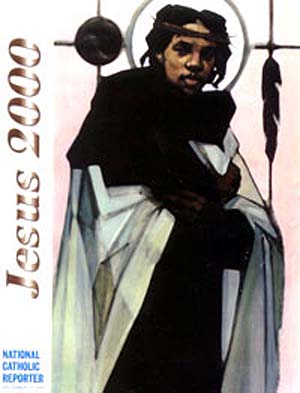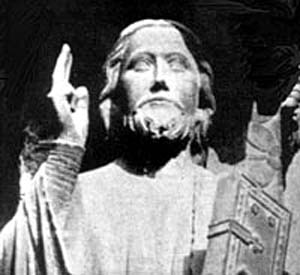 |
Art & Architecture
'Jesus 2000' - A New Model Ideal
Atila Guimarães & Marian Horvat
Human nature has need of models, not only common models, but also ideal models. Why? Because our gaze should be turned to another nature, more perfect that ours, the angelic nature - in which all the perfections that subsist in God and the possible perfections of human nature are personalized. If we could have a communication, a “social life” with the angels, we would be able to “converse” with the very personification of charm, Mr. Charm, lets say, or Mrs. Elegance, Sister Harmony, Brother Prudence and so on. Thus the angels would personalize principles that now we only have in an abstract and philosophical way. They would act as a kind of synthesis of the abstract, the symbolic and the concrete that our sensible human nature requires.

The progressivists portray what they would like Our Lord to be... |
With original sin, man lost much of the capacity he had to also represent and symbolize model ideals. But after the Redemption, some of the characteristics of the paradisiacal capacities of man were restored. It is normal for Catholics to think immediately of saints as model ideals, and this is true. Because of the heroic practice of virtue and correspondence to grace, St. Benedict has come to personify solemnity, St. Francis of Assisi, poverty; St. Ignatius de Loyola, militancy; St. Frances de Sales, meekness; St. Teresa of Avila, mysticism and radicality, and so on. Each person seeks the model ideal that is closer to him. Perhaps few Catholic housemaids in Italy have chosen St. Thomas Aquinas as their daily confidante and intercessor, but many are led naturally to follow St. Zita of Lucca as a model ideal.
Throughout History, there also have been model ideals for both the good and the evil in temporal society. To give some examples from French history: models of the primordial light of this country were personalized by Clovis, Charlemagne, St. Louis IX, Francis I, Louis XIV, Marie Antoinette. The capital vice of France also has had its model ideals: Phillipe le Bel (grandson of St. Louis), Eleanor of Aquitanie, Henry IV, Decartes, Phillippe Egalité and his son Louis Phillippe , Robespierre, and Lammenais.
These chains of good and bad could be traced for every nation (and every family), and obviously are open to discussion. But more than names of particular persons, we are interested in establishing the principle and how it applies to concrete reality. For, in our opinion, one of the most important laws of social and cultural life is to discern the model ideals that individuals, peoples and nations have adopted throughout centuries.
At times an interesting idealization that a whole people can occur and can shine with special brilliance. Spain as the stronghold of the Catholic ideal in the 16th century and Portugal as the nation of seafaring explorers and missionaries in the Age of Discovery are significant examples.
Today, in the name of “the objectivity of history,” some positivist scholars are trying to destroy these idealizations of our ancestors. “You can’t make generalizations about any people,” they say. They would especially like to destroy certain personages, such as Charlemagne, the Holy Roman Emperor, idealized as the greatest medieval warrior and Father of all Europe, and portrayed with a magnificent long beard adorned with flowers.
To destroy model ideals, this positivist school is trying to prove that Charlemagne did not have a beard, that Clovis did not have a vision in the Battle of Tolbiac, that the Holy Chrism was not brought by a dove from Heaven for the coronation of the Kings of France, that Constantine did not see a Cross in the sky at the battle of the Milvian Bridge, etc. This kind of discussion aims less at establishing a historical reality than at the destruction of an idealization - the glorious model ideals that have stimulated so many individuals and peoples to noble ideas and grand gestures.
The apex of perfection: Our Lord Jesus Christ

13th century Christ, Cathedral of Amiens,
France, 13th century |
Peoples in their different classes naturally develop human types that approximate their own model ideals. But there is a monarchical point of reference in this process. In Christian Civilization, the ideal human type for all classes, the very incarnation of perfection, is the person of Our Lord Jesus Christ, true God and true Man. His figure, throughout History, has reflected the perfection of human nature elevated to the divine through the hypostatic union. Therefore, the elaboration of the divine figure of Our Lord Jesus Christ throughout the centuries has sought to represent the ideal human type par excellence.
Some time after His death, no one knew the exact characteristics of His Face, His size, His way of walking and being, the tone of His voice. But the figure of Our Lord was soon being drawn and sculpted, inspired by oral tradition and the love of the faithful.
This process that lovingly tried to reconstitute the features of the Savior began after His Resurrection, and Tradition transmitted to the posterity the successive phases of elaboration. This chain had continued for nineteen centuries, when, in 1898, the famous Shroud of Turin was photographed for the first time by Secondo Pia.
The negative of that photograph revealed in detail, and with an astonishing clarity the figure of Our Lord crucified. For the first time in History, we had the real picture of Our Lord. What is marvelous to consider is that this process of elaborating the face of Christ throughout History in essence revealed the same features as those of the Shroud of Turin. Consider, for example, this face of Christ from a statue in front of the Cathedral of Amiens, France, in which Christ is presented with all human virtues present in a perfect way. Sculpted in the 13th century, it nonetheless closely approximates the image on the Shroud of Turin.
The Shroud of Turin is a confirmation that the Holy Ghost inspired and protected the elaboration we mentioned of the true Face and Body of Our Lord. It is proof that the figure of Our Lord we are accustomed to adore is not only a cultural elaboration, but is really a work inspired by both the Catholic sense and the Holy Ghost. This figure is, therefore, one that cannot be changed according to the whim or caprices of individuals, groups, peoples or an era. This is an objective figure that must be maintained.
A shocking and blasphemous representation of Christ: Jesus 2000
With this presupposition in mind, we were profoundly shocked and offended when we opened the December 25 special issue of the “National Catholic Reporter” and saw the results of its international art competition, the search for “Jesus 2000.” The contest received a lot of publicity, and, in the end, 1,678 entries were submitted by 1,004 artists from 19 countries and six continents. A final panel of three art experts selected ten finalists, from whom Sister Wendy Beckett (famed BBC art expert) picked the winner.
First and foremost, the criterion for the contest was based on a profound error in interpretation. According to the NCR competition, the new figure of Jesus, called to be the new “icon” for the next century, ought to be a subjective drawing, not a reality transmitted through tradition to us. According to the promoters and judges of the competition, the new icon would be an “exploration in visual art,” “an idealization, an incarnation of our best imagining.” In short, a subjective opinion that is supposed to substitute the objective figure of Our Lord.
The winning picture, entitled “Jesus of the People,” received the general title of “Jesus 2000.” It is obviously an attempt to change the model ideal of Our Lord. The picture is shocking to the Catholic sense. The young person presented for our adoration is neither man nor woman. In fact, the artist Janet McKenzie used a female model to achieve a “man whose features reflect feminine elements.” Its face has a mulatto color and various African characteristics. There is no beard. Nothing in the physiognomy reminds us of Jesus Christ Who was white and Hebrew. On his/her head there is a crown of thorns, but there is no trace of any wounds or blood, no signs of the flagellation. The tunic the figure wears makes it appear more like a Dominican monk than the Man-God suffering the steps of the Passion.
Analyzing the face, the flaring nostril seems to reveal an unbalanced and ungoverned temperament. The lips, carnal and slightly parted, appear to express a singular sensuality. In the eyes, we can see a tired, defiant gaze, which could easily reflect a disillusioned life of alcohol, drugs, and a certain moral shamelessness. No hope. No supernatural aura. No idealism. No goodness. No sense of obedience. No intelligence able to penetrate the reality, to understand society, to prepare the future Church. No will to redeem man from evil, error and sin. No universal view over the past, present and future of mankind. Just the intense suffering of a person on the verge of despair. The vicious passivity of this figure has nothing to do with Catholic peace. The figure projects more of a sense of pagan fatality than obedience to the designs of God. Moreover, it does not take much spirit of analysis to see that this adrogynous person is far from being pure. This androgynism suggets many sorts of unnatural sins which are not convenient to describe here.
There are two strange symbols in the pink background, the only spark of color in the almost monotone picture. Does this pink represent sympathy with the homosexual culture? Perhaps. One of the symbols, which Sr. Wendy mistook for a black host, is the Chinese pagan yin/yang symbol, which is supposed to represent the perfect harmony of man/woman, the characteristics that supposedly would exist together in every man and woman. The second symbol, which Sr. Wendy mistook for an inverted sheaf of wheat, is an Indian feather that “connotes transcendent knowledge and pays homage to Native Americans,” according to the author.
This “Jesus of the People” is now presented to replace the divine and adorable figure of Our Lord. What will be the reaction of the Catholic sense of the faithful today? Isn’t the choice similar to that which Pontius Pilate presented to the people: either Jesus Christ or Barabbas?
The followers of the new conciliar Church adapted to the world now produce this new monstrosity. Our own rejection is immediate and categorical. We hope readers will analyze this picture in a similar way. What will be the general reaction of Catholics? Of the clergy and the Hierarchy? We pray that Our Lord will not permit yet one more general sin, which would be the negation of His Divine Figure.

|
Art & Architecture | Hot Topics | Home | Books | CDs | Search | Contact Us | Donate

© 2002-
Tradition in Action, Inc. All Rights Reserved
|
 |
|